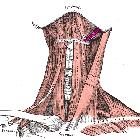hyoid bone


The hyoid is a "horseshoe-shaped" bone that serves as a structural anchor in the mid-neck. It is the only bone in the human body that does not directly articulate with another bone (other than sesamoids). It is a place of convergence of multiple small neck muscles that permit the pharyngeal phase of swallowing. The location of structures in the neck are often described in terms of relation to the hyoid (i.e. suprahyoid neck; infrahyoid neck).
Summary
- location: midline structure located between the mandible and the thyroid cartilage and anterior to the epiglottis at the level of C3
- the level of the hyoid separates lymph node levels II from III in the lateral neck and levels Ia and VI in the anterior neck
- articulations: none
- blood supply: branches of the external carotid artery
- relations: numerous muscles insert on the hyoid, detailed below
Gross anatomy
The hyoid bone is located in the mid-neck, above the thyroid cartilage, anterior to the pharynx. It is divided into three parts:
- body
- greater horn (one on each side, symmetric)
- lesser horn (one on each side, symmetric)
Attachments
Multiple small neck muscles insert onto different parts of the hyoid :
- body
- suprahyoid muscles
- mylohyoid muscle
- geniohyoid muscle
- digastric muscles (indirectly)
- stylohyoid muscle (indirectly)
- genioglossus muscle inferior fibers (indirectly)
- infrahyoid (strap) muscles
- suprahyoid muscles
- body and greater horn
- greater horn
Several ligaments attach to the hyoid:
- lesser horn
- body
- hyoepiglottic ligament
- body and greater horn
- thyrohyoid membrane, including median thyrohyoid ligament
Blood supply
Branches of the external carotid artery, predominantly the infrahyoid branch of the superior thyroid artery, and branches of the lingual artery.
Relations
The position of the hyoid defines a few lymph node levels of the neck:
- anteriorly: hyoid separates levels Ia (above) from VI (below)
- laterally: hyoid separates level II from level III
Radiographic features
The hyoid is the ossified horseshoe-shaped structure just superior to the thyroid cartilage.
Related pathology
- hyoid bone fracture
- movement of the hyoid (hyoid elevation) is an indication of the strength of the pharyngeal muscles during a modified barium swallow study.
Siehe auch:
- Musculus geniohyoideus
- Musculus mylohyoideus
- Musculus omohyoideus
- Schädel
- Musculus thyrohyoideus
- Musculus stylohyoideus
- Musculus sternohyoideus
- Sistrunk-Resektion
- Musculi infrahyoidei
und weiter:

 Assoziationen und Differentialdiagnosen zu Os hyoideum:
Assoziationen und Differentialdiagnosen zu Os hyoideum:







